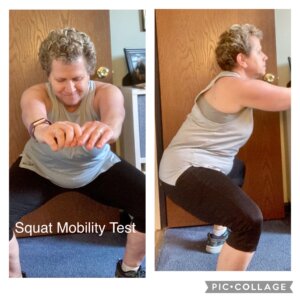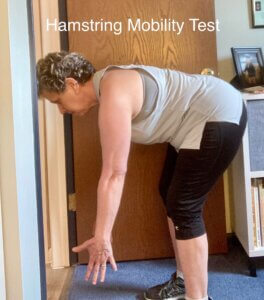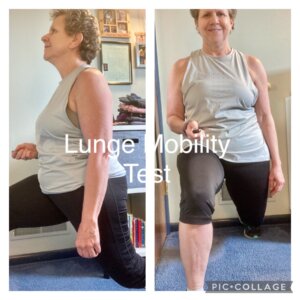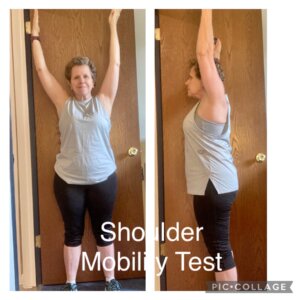By: Jackie Confalone
Think you’re physically fit? Complete physical fitness means more than being able to run a mile, bike for thirty minutes, lift weights, or take group fitness classes. True physical fitness includes five key components:
1. Cardiovascular endurance
2. Muscular strength
3. Muscular endurance
4. Flexibility
5. Body composition
Of these five, flexibility is the most neglected component of fitness across the general population. Flexible joints are vital to maintaining pain-free and independent movements.
Flexibility is defined as the ability of a joint or group of joints to move through a range of motion. For example, if you can reach down and touch your toes with straight legs, we would say that you have flexible hamstrings (the muscles in the upper part of the back of your leg). Many definitions also add ‘pain-free’ as a component of flexibility, i.e., if you can move your joint through a full range of motion but it really hurts, that doesn’t count as flexible.
Flexibility is important at any age for completing everyday tasks including getting out of bed; lifting groceries, babies, small children, or anything with weight; bending to tie your shoes; getting dishes, pans, or utensils from a high or low shelf; turning your head from side to side while driving to check traffic; and getting in and out of a car, to name a few.
There are three types of flexibility training: static stretching, dynamic stretching, and myofascial release.
Static stretching is what most people think of when they think of stretching to gain flexibility. It involves moving into a position that lengthens a muscle and then holding that position for anything from twenty seconds to five minutes. The best time to do this is after a workout when your muscles are warm, and you have good blood flow. Static stretching is also good after a warm bath or shower or before bedtime to relax. Yoga and Pilates classes also use a lot of static stretching.
Dynamic stretching involves moving in and out of various positions that lengthen certain muscles. For example, performing leg swings, shoulder and arm rotations, or exercises like squats and lunges. Dynamic stretches are often included in the beginning of personal sessions or group fitness classes to warm up large muscle groups, increase blood flow and improve joint range of motion.
Myofascial release is often seen around the gym in the form of foam rolling. Although not as relaxing as a personal massage, the foam roller is a form of self-massage that can be used to relieve muscle tension, reduce stiffness, increase blood flow, and decrease soreness. Foam rolling only produces temporary effects on the muscles, generally only 10 to 15 minutes. Although many use foam rollers to reduce muscle soreness and stiffness after exercise, rolling out before exercising increases blood flow and may reduce muscle tension for better performance.
Benefits of flexibility training:
– Allows greater freedom of movement and improved posture
– Improves performance of daily activities
– Increases physical and mental relaxation
– Releases muscle tension and soreness
– Reduces the risk of low back pain
– Decreased risk of injury due to more pliable muscles
How flexible should you be? You should be flexible enough to achieve:
(see photo illustration of moves at the bottom of the page)
1. A deep squat with proper form
Each time that you sit down and stand back up, bend your knees to tie your shoe, or bend to get something from the ground, you are performing a squat. If you are not flexible enough to achieve a proper squat position, then you are significantly increasing your risk of injury to your knees, your hips, and even your back.
2. 90-degree bend at the hips with a flat back and relatively straight knees
Adequate hamstring flexibility is what will allow us to perform one of the most important exercises of all time, the deadlift. Deadlifts teach us how to maintain a braced, neutral spine when picking up something heavy from the floor. Have you ever seen someone who pulls out their back from lifting everyday objects? People often injure themselves in these scenarios because they do not know how to perform a proper deadlift.
3. A full range of motion lunge
Being able to perform a lunge is important because it closely represents several everyday movements. Every time you run, go upstairs or kneel, you are performing a lunge pattern. It would be nice if everything we did in this world involved both of our limbs simultaneously, but most of our everyday movements involves just one leg.
4. A full overhead reach without arching your back
We determine shoulder flexibility by looking at your ability to raise your arms directly over your head. You need shoulder flexibility to be able to reach overhead into shelves and cabinets, to hang from a bar or a ledge, and to throw a ball. You may be thinking, “Who cares, so what if I can’t reach overhead properly or throw a ball?” Not reaching through the full range of motion of a joint is how you develop arthritis, pain, injuries, and the need for orthopedic surgery.
5. Full-knee flexion with your ankles flat on the floor
You’re probably wondering, “What the heck do my ankles have to do with anything?” Your ankles have a lot to do with everything. Your body is one machine. If one thing breaks or doesn’t function properly, it will cause a chain reaction and force other parts to compensate.
If you tried these five flexibility tests and determined that you’re about as flexible as a flagpole, don’t despair. Here is a link to nine stretches to improve your flexibility fast.
So, with all these benefits, why don’t more people stretch or do flexibility training? Time. Many say they don’t have time to stretch before or after their workouts. Others leave group fitness classes before stretching or cool-down exercises at the end. Yet, even five minutes of stretching at the end of exercising is better than nothing to reduce muscle soreness or cramping.
Some ideas to fit stretching into a busy schedule:
– Do stretches on different parts of the body after a shower or even while soaking in a hot tub. The hot water elevates body and muscle temperature enough so it’s safe to stretch them.
– Try a few stretches before you get out of bed in the morning. This can help you wake and get you moving.
– Take a yoga, Tai Chi, or stretch class at least once a week to help you consistently stretch and challenge yourself. Body Zone has many of these classes in the main Group Fitness, Active Aging, and Aqua Fitness offerings.
Ideally, you should do flexibility training five to seven days a week for all major joints to keep pliable muscles throughout your body. Here are general tips for stretching:
– Frequency. At least three days a week
– Intensity. Stretch muscles when warm to the point of a challenging stretch/mild discomfort, not pain.
– Time. Hold stretches for at least 20 to 30 seconds; do them 2-3 times for the same area, if possible.
– Type. Static stretching of major muscle groups/joints (holding the stretch, not bouncing)
To these four tips, I would add breathing. Do not hold your breath while stretching but take deep breaths to get more oxygen to the muscles and to help you relax.
Always remember, the best time to stretch is when your muscles are already warm, such as after a workout or after a warm shower before bed. If you enjoy being physically active, then it is good to have flexibility for overall health. Maintaining some degree of flexibility is even more important as you age, as older adults naturally lose their ability to do certain activities of daily living.
So, determine where you lack flexibility and get to work stretching those muscles!
Sources:
The Impact of Flexibility Training on Performance (acefitness.org)
How Flexible Are You? 5 Useful Ways to Test if You Need to Stretch – The White Coat Trainer
About Jackie Confalone:
Although retired from full-time work, Jackie is a freelance writer and has been a group fitness instructor for more than 35 years, the last 13 at Body Zone. She particularly loves working with seniors and people with chronic illnesses. She is nationally certified as a personal trainer and instructor for group fitness, Les Mills BODYFLOW, Pilates and SilverSneakers.





